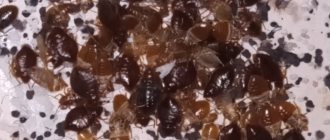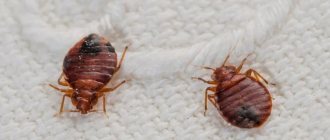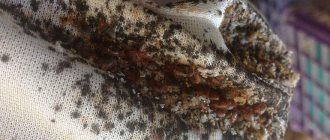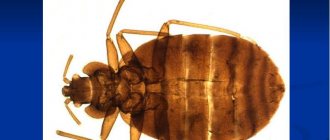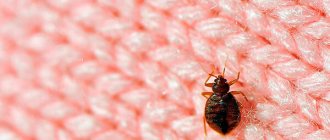Large water bug belostoma
Belostoma sp. is a giant water bug up to 15–17 cm long. These are the largest representatives of the order Hemiptera on the entire planet. Distributed in East and Southeast Asia. Has a terrifying appearance.
The body is oval-shaped, elongated, black, yellow-brown or brown in color, covered with small hairs. Coloring allows you to camouflage yourself with surrounding objects. The front legs are strongly curved, with hooks at the ends resembling claws, they allow them to capture and hold prey. The eyes are large and reticulated. The wings are membranous, transparent and smoky in color.
Giant Belostoma bug
Belostoma lives in tropical and subtropical regions of the planet. In some warm countries, locals call them “Alligator Ticks.” Two species are found in the Far East. Lives in shallow reservoirs, both flowing and standing, rich in vegetation. Spends most of its life under water, breathes atmospheric air, for which it sometimes floats to the surface. The openings of both respiratory tubes of these bugs are located at the end of the abdomen. Therefore, in order to take a breath, he needs to stick the back of his body out of the water. The bug swims well, its hind legs act as oars.
Giant belostomas spread to other bodies of water by air. Sometimes in the dark they can be attracted to lighting fixtures, which is why the insects received the nickname “electric-light bugs,” which means “electric light bugs.” At this time, a belostoma can easily hit a random passerby in the face.
Giant bedbugs have a peculiar reaction to impending danger. If a belostoma encounters an enemy larger than itself, it freezes, pretending to be dead. In another case, the insect may release an odorous liquid from the openings of the glands at the end of the abdomen.
It is common for Far Eastern white stomas to leave for the winter. With the onset of cold weather, they leave their ponds and find shelter in the crevices of dry stumps and fallen trees, densely overgrown with moss and lichen. In such a shelter, they fall into a state of suspended animation in order to survive the shortage of heat and food. Wintering ends with the establishment of a constant warm temperature, ensuring sufficient heating of water in reservoirs. Immediately after emerging from their hiding places, belostomas actively feed to replenish the nutrients lost during the winter.
Giant Belostoma bug
Classification
Waterbugs are members of the class Insecta. The giant one belongs to the family Belostomatidae, one of the 50th order Hemiptera.
The Belostomatidae family includes about 100 species, living mainly in North America, South Africa, and India. In North America, Abedus herberti is distributed throughout Arizona, some adjacent states, and Mexico.
| Habitat Clean freshwater streams, ponds. Prefers aquatic vegetation. | physical characteristics They are about 1.5 inches (3.8 cm) long. Some species grow up to 4 inches (10 cm) and have a single pair of tiny, almost invisible antennae located just below the compound eyes. Giant water bug teeth elongated into a beak-like structure designed for biting and sucking. The body is brown, flat, oval, reminiscent of a cockroach. The front legs are raptorial (grasping) to capture prey. The other two pairs of legs are flattened and bordered with hair to increase the surface area. Used as oars for movement. Adults have two pairs of wings, but rarely fly unless forced by unfavorable water conditions or lack of an adequate food supply. The rear part has two retractable semi-cylindrical extensions, which when connected form a breathing tube. It is used for underwater breathing. | Life expectancy is one year or longer. | Diet In the wild: larvae feed on small aquatic invertebrates. Adults hunt small animals that they can handle, including insects, aquatic invertebrates. They also hunt vertebrates such as tadpoles, salamanders, small fish. At the zoo: crickets |
Belost lifestyle
Belostomas are carnivorous predators; they hunt by waiting for prey in a shelter. They feed on fish fry, amphibians, tadpoles, aquatic insects, and fish. The insect pierces the body of the victim with a sharp proboscis, introduces a digestive enzyme into the tissue, then the bug sucks up the resulting mass. These predatory bugs prey even on well-protected armored animals, looking for unprotected places on their bodies. Thus, Belostomas became the cause of mass death of three-keeled turtles in Japan.
Important! Belost bites are not dangerous for humans, but if the enzyme contained in the saliva gets on the skin, it will cause discomfort. While swimming, these insects can bite people's toes and heels. A wound will form at the site of the bite, which will take a long time to heal.
Pictured are Belostoma bugs and their victims
Is it dangerous for humans?
This insect does not pose an immediate danger to humans. These aquatic arthropods do not consider humans as prey due to their huge size difference.
Aquatic predators choose small prey that live next to them.
At the same time, these insects are not absolutely safe for people. Under certain circumstances they bite, but they do this extremely rarely. Curious children who stick their hands everywhere often suffer from them.
If they catch such a predator, they risk receiving a sting reminiscent of a bee. Although the poison that saliva contains is not dangerous to humans, the bite site can be felt for a long time.
Reproduction
The period of mating and egg laying occurs in the spring. One oviposition contains up to 100 eggs, laid at different times. One female lays up to 4 eggs at a time, so the bugs mate several times until the required number of eggs is laid.
Belostomas are classified as insects with an incomplete type of transformation. That is, throughout their life they go through only two stages of development: the larva and the imago (adult insect). The beginning of the larval stage is considered to be the exit from the egg. Newborn larvae lack normal coloring and their body coverings are soft. The larvae's integument gradually hardens and becomes colored, after which they enter a phase of increased feeding. The stage of increased growth is accompanied by several molts, when the larva sheds the chitinous cover that has become cramped for it. This is how the body enlarges and transforms into an adult form.
Victim of the belostoma bug
Giant bedbugs - who are they?
Fortunately or unfortunately, there are no giant waterbugs in our area. Giant water bug is an alien tropical creature. Belongs to the genus Belostoma. Reaches a length of 15 cm. The color is brown with different tints. The terrifying appearance of an insect does not mean that it is dangerous to humans. Giant water bugs have 3 pairs of limbs. The front ones are bent in the form of claws. With them, the predator grabs the prey and pulls it towards itself.
Hunting process and nutrition
Giant water bugs can be found in bodies of water with standing water. The Belostoma giant water bug prefers to hunt at night. Water bugs choose a convenient place and simply freeze. When the victim approaches, the giant bug quickly grabs it with its pincers. Belostoma's saliva contains a substance with a nerve-paralytic effect. The victim has no chance of surviving if the waterbug injection has already followed. Giant water bugs are interested in large insects, frogs, and small fish. The giant belostoma bug itself rarely becomes a victim.
Reproduction
This point requires special attention. Caring for future offspring is completely transferred to the strong back of giant water bugs - papas. The female Belostoma lays 3–4 eggs directly on the back of the male. He does this until there are about 100 pieces there. The back of giant water bugs can easily accommodate this amount. From now on, all responsibility is shifted to dad. The water bug carries them for 2 weeks. Periodically, the giant water bug rises to the surface and exposes its back to warm up. In this way, the larvae avoid the formation of mold and the accumulation of harmful microorganisms. In this form, belostoma resembles a hedgehog.
The harm and benefits of giant water bugs
There is no need to fear for a person’s life or health when encountering this water bug. Belostoma does not hunt humans. In addition, it is preferable for giant water bugs to quickly take refuge in a safe place. However, highly persistent and curious people run the risk of being bitten. Water bugs bite like a bee or wasp. There won't be any big consequences. There will just be redness and swelling. The sore spot will calm down after a week.
On the contrary, Belostoma is considered a very useful bug. Water bugs are the only creature that can calmly deal with pests such as three-keeled turtles. They pose a great danger to the younger generation of commercial fish.
In addition, giant harmless water bugs themselves suffer from human hands. Giant water bug is served fried in Thai restaurants. The demand for such exotic dishes is quite high. Therefore, in some lakes the giant bug remained in small numbers. And on farms they are trying to breed them.
The bug is not always harmful and dangerous to health. Reckless destruction of these creatures is strictly prohibited. Even if a wonderful dish is prepared from a bug. Everything in nature is interconnected! Perhaps, in the era of global warming, such large creatures will appear in our ponds. You need to know how to meet them.
Caring for offspring
Some Belostomas have a pronounced concern for their offspring. Fertilized females lay eggs on the backs of males.
The male carries the eggs for about two weeks. At the same time, it does not sink to the very bottom of the reservoir, but stays closer to the surface and, with the help of its hind legs, ensures water circulation because future offspring need access to air.
The male carries the eggs until the larvae hatch. During this period, he begins to eat less because... oviposition on the back limits its movement. Such insects become easy prey for predators. Therefore, by the end of the breeding season in reservoirs, the number of females exceeds the number of males.
In Japan, the belost is highly revered, knowing the ability of their males to take such careful care of their future offspring. It is this feature that has made the white bug a unique symbol of a father who does not abandon his child under any circumstances.
Male Great Belostoma bearing offspring
Male Great Water Belostoma with hatched larvae
The role of belostoma in nature
The Belostoma water bug, being a predator, participates in the processes of regulating the number of other animals, including harmful ones. For example, in Japan, a mass death of three-keeled turtles was noted, causing damage to rice crops. A zoologist from Kyoto University managed to record the fact that a giant belostoma hunted a three-keeled turtle. This event significantly reduced the impact of pests on crops.
However, whitestomas can cause harm by eating the fry of rare or commercial fish. This could result in losses for fisheries.
Interesting! In some exotic countries, large white water bugs are a national specialty that you can buy and try right on the street. For this reason, Thailand has seen a decline in the number of these insects.
Review:
Very cheap dish in Thailand! It tastes like chicken, I recommend it to everyone!
Vladimir, Moscow
Fried belostomy as a dish of exotic cuisine



